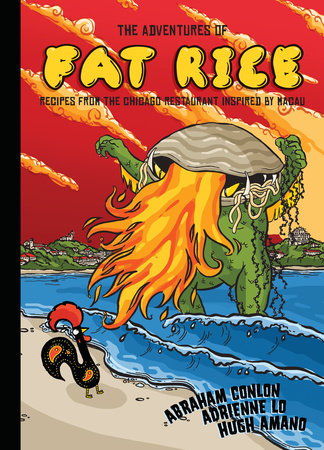Excerpt
The Adventures of Fat Rice
MACAU RICE CRISP
Makes 24 fun-size portions
A Fat Rice classic! The idea for this tasty treat came from the Yat Heng Tong Bakery on the island of Taipa during our first trip to Macau. There we found a Taiwanese baker making crisp puffed rice balls coated with all kinds of things, but the one that stood out for us was the one with nori and rousong (pork floss)—a weirdly delicious, fluffy, MSG-laden porcine treat. The balls had the texture similar to Rice Krispies Treats, with a super-addictive, slightly oceanic, and savory taste. Back home, we added sesame and chilli flakes, and the dynamic texture of not-melted-all-the-way marshmallows for a strangely delicious taste combination of sweet and salty, with a bonus porky flavor putting it over the top. Making this dessert is a rite of passage at Fat Rice that all new cooks need to master, and it is always interesting to watch how someone not from the United States (and therefore, who has never made or even experienced Rice Krispies Treats before) interprets the recipe.
10 nori sheets, about 7 by 8 inches
1 cup rousing
9 ounces (about 11 cups) puffed rice cereal
1 tablespoon sesame seeds, toasted
1 tablespoon Korean chili flakes
4 tablespoons unsalted butter, plus a bit to grease hands
½ teaspoon salt
1 tablespoon toasted sesame oil
1 (28-ounce) bag marshmallows
Finely julienne the nori sheets into strips about 1 inch long—you’ll need a good, sharp knife and some serious elbow grease, or take the nori into your office after everyone else is gone and use the boss’s paper cutter.
On the bottom of a dry 9 by 13-inch baking dish, first sprinkle half of the rousong, then half of the nori on top of the pork and set aside. You want the pork floss to be on the outside of both sides of the rice crisps or the seaweed will not adhere.
Toss the cereal, sesame seeds, and Korean chilli flakes in a bowl and set aside.
Melt the butter with the salt and sesame oil in the biggest and widest pot you’ve got. Add the marshmallows and stir to slightly melt, taking care not to melt them more than about halfway, just a few minutes. Remove from the heat and immediately add the cereal mixture, stirring well to combine. With buttered hands, press the cereal mixture firmly and evenly onto the floss and seaweed in the baking dish, pressing into an even layer. Top with the remaining seaweed, followed by the remaining pork floss. Top with parchment paper and weight down with another baking dish or something similar. Allow to cool for 1 hour, weighted, then remove from the pan and cut into serving-size portions. Serve immediately. Store any leftovers tightly wrapped at room temperature for up to 5 days.




